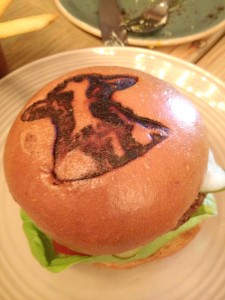The Fat Cow sacrifices taste for decor
British celebrity chef Gordon Ramsay’s casual dining spot The Fat Cow represents the latest culinary addition to The Grove shopping center, replacing The Farm of Beverly Hills on Oct. 1 with farm-fresh foods at Beverly Hills prices.

Moos for the money· The Fat Cow accents its clever creations with images indicative of its brand. Though these details are a nice touch, the restaurant clearly prioritizes atmosphere over quality dishes. – Sara Worth | Daily Trojan
The Grove opened in 2002 as an antidote to the vintage charm of The Farmer’s Market with hopes of drawing wide-eyed tourists and the L.A. glitterati back to Third Street. As an addition to the high-end shopping center, The Fat Cow ultimately offers pleasant, casual food informed by high-rent sensibilities, yet falls short of its highly anticipated gourmet caliber.
Described by a waiter as “California comfort with a London flair,” The Fat Cow’s pricey-yet-accessible menu of tavern staples could elevate any movie night. Its flexibility and wealth of options make it a prime spot for families and romantic occasions, and its distinctly English offerings, such as shepherd’s pie and sticky toffee pudding, help make The Fat Cow an exciting new novelty spot in the company of chain restaurants.
As television host of Hell’s Kitchen and Kitchen Nightmares, Ramsay has made exceedingly clear his commitment to exceptional food and service. He is known as a temperamental perfectionist and holds several Michelin stars, a rare recognition awarded by anonymous reviewers in annually released Michelin guidebooks.
In line with Ramsay’s critical recognition, The Fat Cow shines most through its comfort foods. The mac & cheese, served in a cast-iron pan, has a lovely texture from its crispy breadcrumb top to the gooey, bechamel bottom. The meatballs are light and herby in a sweet tomato sauce. The Fat Cow Fries are crispy and not greasy, with a distinct potato flavor indicative of the restaurant’s commitment to fresh market produce. The Buffalo Mozzarella and Vodka Sauce Pizza is nearly divine and well worth $15, with its perfectly crispy, semi-blackened and stone-baked crust.
Unfortunately, a number of other dishes fall short of expectations.
The Fat Cow Cheese Burger is a child’s idea of a “medium” cook — dry, tasteless, void of any pink at the center. Its brioche bun looks delightful with an embossed cow logo, but tastes like it might have come out of a freezer and barely been warmed through. The Caesar salad appetizer is mild and tasty, yet overdressed. Overwhelmed by grated Parmesan cheese and victimized by crumbly, underwhelming croutons, the salad stands as a disappointment brightened only slightly by the presence of a single soft-boiled egg.
At dessert time, The Moo Bar falls a bit short as well. The Eton Mess is perhaps appropriate for the mess hall at an aristocratic English college, but the inclusion of modest bits of crumbled meringue is not worth the $10 spent on a glorified berry parfait.
The Fat Cow boasts more attention to detail in its decor than in its fare. High-ceilinged and naturally well-lit, the room feels large and has ample seating. The rustic-chic communal tables and brown leather booths (with hobnail upholstery tacks) are comfortable and catalyze conversation. Faux-rustic trappings — Edison bulbs, packing-crate light fixtures, raw wood beams, rope and milk bottles — feel hip but not overly designed. From its salvaged-wood mirrors to its barn-door bathroom stalls, the design scheme reflects the hybrid, transcontinental theme of the restaurant.
But this theme feels perhaps overdone and inauthentic in The Fat Cow’s attempt to conform to its upscale locale. In Ramsay’s attempt to bring gourmet English food to West Hollywood at reasonable prices, some integrity has been lost in translation.
Despite an attempt to bridge an authentic English tavern aesthetic with that of smooth, contemporary Los Angeles, the only real British presence is that of The Libertines’ second album on the stereo. With “Fat Cow” written on the wall with Green Room-style bulbs, the restaurant conforms to its flashy surroundings. The dark brick veneer lining the walls reveals an unexpected shallowness. The menu features at least three distinct typefaces, but includes the glaring typo “Fires” instead of “Fries.” Mistakes such as this one seem appropriate for a stale corporate endeavor but not for a brand-new brain project. The Fat Cow seems more like a branch of a chain than the new casual dining adventure of a famous restaurateur.
Lunch at The Fat Cow is an alienating experience, with prices not justifying the inconsistent quality of dishes customers receive. In this sense it fits in perfectly at the mall — a place to spend money and feel en vogue. The dining spot is perhaps the best executed version of a typical Grove destination — expensive and glitzy but ultimately disappointing — and not worth the hassles of parking.
Ramsay’s latest installment offers stylishly delivered, above-average British and American fare. The Fat Cow might offer unique dishes, such as a steak cooked in an au courant water bath, but does not satisfy across the board. It better serves its patrons in its more classic comfort dishes — customer-oriented, inviting meals — than in higher-rent offerings. Several distinct menu options are worth the tab, but at The Fat Cow, you’re really paying for the rent.

Having had lunch at the Fat Cow, I find this article remarkably accurate and entertaining–way better than my lunch–and yes, parking is a hassle.
I think your harsh review of ramsays restaurant is absolutely outrageously harsh..and I haven’t even eaten there yet. additionally, anyone who refers to eating in a restaurant as an “alienating experience” needs to take a writing class…no wonder the only publication that would hire you bears the name of a prophylactic!!!!!
Wow, real mature.
You donkey you burned the risotto!